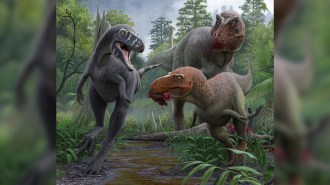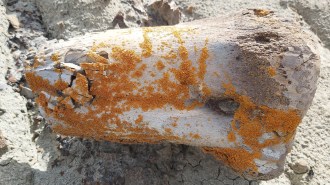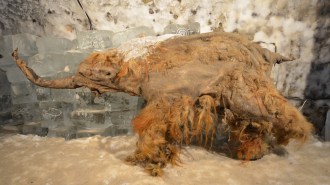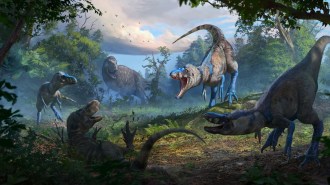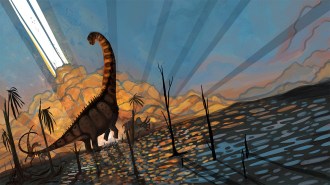New evidence weakens case against climate in woolly mammoths’ death
Age of weaning suggests warming not responsible for megafauna extinction
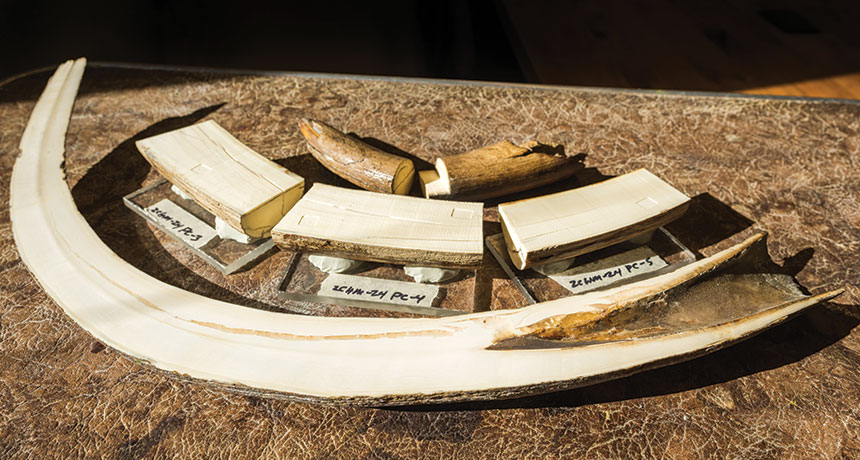
YOUNG TUSKS Juvenile Siberian woolly mammoth tusks (shown) reveal that, at the end of the Ice Age, the animals weaned young, suggesting that climate change wasn’t the main driver of extinction.
Daryl Marshke, Michigan Photography
DALLAS — The story of woolly mammoths’ demise could be written in their tusks.
Human hunters, not climate change, killed off the Ice Age mammals some 10,000 years ago, a new chemical analysis of youngsters’ tusks suggests.
If preliminary results hold up, they’ll “help convince more and more people that hunting was the main driver of extinction — or at least that climate change wasn’t,” said paleontologist Michael Cherney October 15 at the Society for Vertebrate Paleontology annual meeting.
Unsurprisingly, the findings have already drawn some skepticism. The mammoths’ extinction has sparked debate among scientists for decades, said Roger Wood, a paleontologist at Stockton University in Galloway, N.J. Still, Cherney tackled the question with a new approach, Wood said, and “it’s let him come to a seemingly very clear conclusion.”
Scientists know that woolly mammoths bit the dust at the end of Earth’s last glacial period. But no one knows exactly why. Some think human hunters may have finished the animals off — ancient people did migrate to the mammoths’ turf right about when they went extinct, said Cherney, of the University of Michigan in Ann Arbor. Other scientists argue that a warming climate wiped out the massive beasts. Higher temperatures could have shriveled up the plants that mammoths fed on (SN: 3/22/14, p. 13), making it hard to find enough food to survive.
But Ice Age animals had gone through warming periods before, “and none of those were associated with a big extinction,” said David Polly, a paleontologist at Indiana University in Bloomington.
One recent analysis tied extinction to abrupt spikes in temperature, which would have given animals little time to adapt and could have made them vulnerable to hunting (SN: 8/22/15, p. 9).
Cherney realized that a changing climate might leave a chemical mark on young mammoths’ bodies. Living tissues contain both heavy and light versions of nitrogen. The ratio of heavy to light nitrogen tends to drop as juveniles taper off mothers’ milk, but babies nurse longer than usual if they’re stressed by lack of food or water, he said.
To figure out mammoths’ weaning ages, Cherney reasoned, he could analyze nitrogen levels — because the chemicals were deposited in mammoths’ tusks as they added new growth each year.
Cherney ground off powdered samples of ivory from the tusks of about a dozen Siberian mammoths that lived between 10,000 and 40,000 years ago. He analyzed nitrogen levels to figure out when each young mammoth weaned.
Story continues after video
|
3-D SCAN Woolly mammoth tusks grow in annual layers, like the rings of a tree. Using 3-D scans of juvenile tusks (one shown), researchers could identify the increments of growth. M. Cherney |
Weaning age ping-ponged up and down as temperatures changed, Cherney and Michigan colleague Daniel Fisher found. During the last glacial maximum, the coldest period before the Ice Age ended, mammoths weaned at around 7 years old. But as temperatures warmed, weaning age dropped to around age 4.
The results suggest that frigid temperatures were actually more stressful for woolly mammoths than warmer weather. And that doesn’t fit the idea that a warming climate snuffed out Ice Age megafauna, Cherney said.
But climate change isn’t the only thing that can drive weaning age down. “It could also be hunting,” Cherney said. Hunting forces animals to mature faster and would probably cause mammoths to wean early, he said.
Evolutionary biologist Alan Cooper of the University of Adelaide in Australia isn’t convinced. Cooper was one of the scientists who reported a link between intense heat spikes and Ice Age animal die-offs.
He pointed out that heavy nitrogen levels in the environment bounce around. And 10,000 to 20,000 years ago, he said, heavy nitrogen “suddenly changes dramatically — it goes down by quite an alarming amount.”
This drop could partially explain the changing nitrogen levels Cherney found in the mammoths’ tusks, Cooper cautioned.


